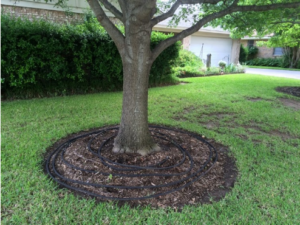Learn about when and how to properly water your tree
We all know that trees need water, but when and how much do they need? Well, depending on who you ask, it may be more complex than you think. According to The Arbor Day Foundation, there are many variables that should be taken into consideration.
Learn more about when and how to properly water your tree, and important factors to keep in mind:
Species of the Tree


Water is necessary for trees but only a small amount of water taken up by the roots is used for growth and metabolism. Transpiration serves to evaporatively cool plants, as the clean evaporating water carries away heat energy through the leaves due to its large latent heat of vaporization.
Typically, tropical trees have larger leaves because they live in a wetter environment. On the other hand, the needles of pine trees are a water conservation adaptation, so evergreen trees shouldn’t need as much water. Deciduous trees that lose their leaves in the fall need a moderate amount of water.
Soil Composition
As a general rule, sandy soils have less capacity to hold water and need to be watered more often. Trees in clay soils, like those found in many places in North Texas, typically have high water retention.
Since Dallas, Texas and surrounding counties typically have soils that are higher in clay content, a slow watering over a longer time results in the water reaching deeper into the soil and less runoff. Runoff is water that was meant for the tree but did not infiltrate the soil and thus missed the target.
Age of the Tree


Since younger trees need more minerals from the soil, it is beneficial to make sure they are getting enough water on a regular basis. After a tree is planted, it is a good idea to water it in the evenings (after 6 p.m.) or in the mornings (before 10 a.m.) for several minutes each day during the growing season (Spring into mid-Fall).
Older, more established trees will have a more extensive root system, and will not need the higher mineral content, so these can be watered less often, maybe even once a week.
Now that you know some of the variables that can affect when and how to water your tree, here’s the general rule of thumb from the majority of arborists: Water your tree approximately ten gallons per week, per inch of diameter of your tree. It is best to do this with drip irrigation or a soaker hose, but feel free to adjust your lawn sprinklers accordingly.
To learn more about tips on taking care of your tree, visit the Texas Trees Foundation Educational resources page.
